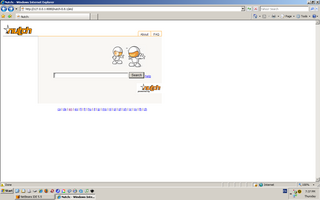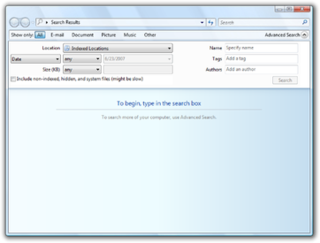
Apache Nutch is a highly extensible and scalable open source web crawler software project.
Apache Lucene is a free and open-source search engine software library, originally written in Java by Doug Cutting. It is supported by the Apache Software Foundation and is released under the Apache Software License. Lucene is widely used as a standard foundation for non-research search applications.
In text retrieval, full-text search refers to techniques for searching a single computer-stored document or a collection in a full-text database. Full-text search is distinguished from searches based on metadata or on parts of the original texts represented in databases.
Content Repository API for Java (JCR) is a specification for a Java platform application programming interface (API) to access content repositories in a uniform manner. The content repositories are used in content management systems to keep the content data and also the metadata used in content management systems (CMS) such as versioning metadata. The specification was developed under the Java Community Process as JSR-170, and as JSR-283. The main Java package is javax.jcr.
Oracle Spatial and Graph, formerly Oracle Spatial, is a free option component of the Oracle Database. The spatial features in Oracle Spatial and Graph aid users in managing geographic and location-data in a native type within an Oracle database, potentially supporting a wide range of applications — from automated mapping, facilities management, and geographic information systems (AM/FM/GIS), to wireless location services and location-enabled e-business. The graph features in Oracle Spatial and Graph include Oracle Network Data Model (NDM) graphs used in traditional network applications in major transportation, telcos, utilities and energy organizations and RDF semantic graphs used in social networks and social interactions and in linking disparate data sets to address requirements from the research, health sciences, finance, media and intelligence communities.
The EB-eye, also known as EBI Search, is a search engine that provides uniform access to the biological data resources hosted at the European Bioinformatics Institute (EBI).

Eclipse RDF4J is an open-source framework for storing, querying, and analysing RDF data. It was created by the Dutch software company Aduna as part of "On-To-Knowledge", a semantic web project that ran from 1999 to 2002. It contains implementations of an in-memory triplestore and an on-disk triplestore, along with two separate Servlet packages that can be used to manage and provide access to these triplestores, on a permanent server. The RDF4J Rio package contains a simple API for Java-based RDF parsers and writers. Parsers and writers for popular RDF serialisations are distributed along with RDF4J, and users can easily extend the list by putting their parsers and writers on the Java classpath when running their application.

Solr is an open-source enterprise-search platform, written in Java. Its major features include full-text search, hit highlighting, faceted search, real-time indexing, dynamic clustering, database integration, NoSQL features and rich document handling. Providing distributed search and index replication, Solr is designed for scalability and fault tolerance. Solr is widely used for enterprise search and analytics use cases and has an active development community and regular releases.
Microsoft SQL Server is a relational database management system developed by Microsoft. As a database server, it is a software product with the primary function of storing and retrieving data as requested by other software applications—which may run either on the same computer or on another computer across a network. Microsoft markets at least a dozen different editions of Microsoft SQL Server, aimed at different audiences and for workloads ranging from small single-machine applications to large Internet-facing applications with many concurrent users.

Windows Search is a content index desktop search platform by Microsoft introduced in Windows Vista as a replacement for both the previous Indexing Service of Windows 2000 and the optional MSN Desktop Search for Windows XP and Windows Server 2003, designed to facilitate local and remote queries for files and non-file items in compatible applications including Windows Explorer. It was developed after the postponement of WinFS and introduced to Windows constituents originally touted as benefits of that platform.

Microsoft Azure, often referred to as Azure, is a cloud computing service operated by Microsoft for application management via Microsoft-managed data centers. It provides software as a service (SaaS), platform as a service (PaaS) and infrastructure as a service (IaaS) and supports many different programming languages, tools, and frameworks, including both Microsoft-specific and third-party software and systems.

Lucene Geographic and Temporal (LGTE) is an information retrieval tool developed at Technical University of Lisbon which can be used as a search engine or as evaluation system for information retrieval techniques for research purposes. The first implementation powered by LGTE was the search engine of DIGMAP, a project co-funded by the community programme eContentplus between 2006 and 2008, which was aimed to provide services available on the web over old digitized maps from a group of partners over Europe including several National Libraries.
OpenSearchServer is an open-source application server allowing development of index-based applications such as search engines. Available since April 2009 on SourceForge for download, OpenSearchServer was developed under the GPL v3 license and offers a series of full text lexical analyzers. It can be installed on different platforms.

Apache Hive is a data warehouse software project built on top of Apache Hadoop for providing data query and analysis. Hive gives an SQL-like interface to query data stored in various databases and file systems that integrate with Hadoop. Traditional SQL queries must be implemented in the MapReduce Java API to execute SQL applications and queries over distributed data. Hive provides the necessary SQL abstraction to integrate SQL-like queries (HiveQL) into the underlying Java without the need to implement queries in the low-level Java API. Since most data warehousing applications work with SQL-based querying languages, Hive aids portability of SQL-based applications to Hadoop. While initially developed by Facebook, Apache Hive is used and developed by other companies such as Netflix and the Financial Industry Regulatory Authority (FINRA). Amazon maintains a software fork of Apache Hive included in Amazon Elastic MapReduce on Amazon Web Services.

LogicalDOC is a proprietary document management system that is designed to handle and share documents within an organization. LogicalDOC is a content repository, with Lucene indexing, Activiti workflow, and a set of automatic import procedures. The system was developed using Java technology.

FUJITSU Cloud IaaS Trusted Public S5 is a Fujitsu cloud computing platform that aims to deliver standardized enterprise-class public cloud services globally. It offers Infrastructure-as-a-Service (IaaS) from Fujitsu's data centres to provide computing resources that can be employed on-demand and suited to customers' needs. The service ensures a high level of reliability that is sufficient for deployment in mission-critical systems.
The following tables compare the major enterprise search software vendors in their classes.
Algolia is a proprietary search engine offering, usable through the software as a service (SaaS) model.
Azure Cosmos DB is Microsoft's proprietary globally distributed, multi-model database service "for managing data at planet-scale" launched in May 2017. It is schema-agnostic, horizontally scalable, and generally classified as a NoSQL database.










